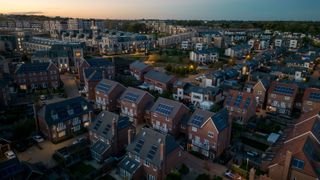5重要外卖从政府的权力ing Up Britain' plan
After the government announced its "Powering Up Britain" plans this week we look at 5 key features of the proposal

"Powering Up Britain" refers to various initiatives and actions aimed at increasing energy generation and improving energy efficiency by the UK government in order to meet its Net Zero Growth Plan.
The government has published plans to greater invest in renewable energy sources, such as wind power andsolar panels, in order to reduce the country's dependence on fossil fuels and meet its carbon reduction targets.
The government has also announced plans to increase energy efficiency in homes, businesses, and public buildings, such as through insulation and improved heating systems. This can help reduce energy consumption and save money on energy bills.
What is the 'Powering Up Britain' plan?
The new "Powering up Britain" strategy was developed in response to a High Court ruling that the government's previous plans were insufficient to meet its climate targets.
The UK government plans to invest in infrastructure and technologies to improve the country's energy efficiency and reduce its carbon footprint, including the installation of heat pumps, the promotion of electric vehicles, and the development of renewable energy sources.
The government has also stated that the strategy aims to lower people's energy bills, but acknowledges that this may not be achieved in the short term.
Below are the specific measures the government has announced as part of its "Powering Up Britain" scheme.
1. Better insulation for homes
The UK government plans to insulate 300,000 low-performing homes as part of a £1 billion energy efficiency programme, potentially saving households £300-£400 annually.
However, some have criticised the programme as a relatively small-scale solution that fails to address the root causes of energy inefficiency.
Glynn Williams, Managing Director ofGrundfos(opens in new tab)- one of the largest pump manufacturers in the world, said: "How disappointing to see a supposedly revamped net zero strategy that repeats previous iterations' focus on insulation. We need to address energy inefficiency at source."
2. On and off-shore wind farms
The UK government has not made a decision on lifting the ban on new onshore wind projects due to strict planning conditions.
While onshore wind is quick to build and is cost-effective, it is politically contentious. The government said it would respond to a consultation on changing planning rules "in due course."
Meanwhile, offshore wind projects are politically easier to build but practically more challenging. The government has reiterated its promise of £160m for port infrastructure to help expand offshore wind, which was first announced in 2021.
3. Carbon capture sites
The announcement of the UK's first carbon capture sites in Teesside is a crucial aspect of the new strategy.
These facilities are designed to capture carbon dioxide (CO2) emitted during the burning of fossil fuels, such as gas, and store it in deep underground caverns in the North Sea.
It is hoped that this process could eliminate up to 50% of emissions from the country's industry.
While carbon capture has been recommended by the UK's independent climate advisers, the UKCCC, as a means of removing CO2 from the atmosphere, some academics express concern that it could encourage continued reliance on oil and gas, rather than focusing on renewable energy.
4. Lowering energy bills
The strategy also aims to ensure that energy bills for consumers remain affordable.
According to Energy Security Secretary Grant Shapps, the proposals would introduce changes to the billing system, resulting in lower electricity prices in the long run.
The government recognises that increasing the share of renewable energy is crucial to lowering bills. However, it also plans to "decouple" electricity prices from gas prices, as natural gas is still necessary to meet current demand in the UK, and gas generators are charging the highest prices.
The government has not yet specified how it plans to decouple prices but has suggested transferring the current "green levies" from electricity prices to gas prices, so that households are not penalised for using cleaner electricity.
5. Reforms to the planning process
The government has dedicated to implementing faster, more equitable, and more efficient planning policies, including revisions to the National Planning Policy Framework.
The government is releasing five revised energy National Policy Statements (NPS) for consultation, including NPS for renewables, oil and gas pipelines, electricity networks, and gas generation. Additionally, an overarching energy statement will also be published.
The government has sought feedback on proposed changes toplanning permissionfor onshore wind in England, aiming to provide more flexibility for local authorities to consider the opinions of their communities.
The government will respond to the consultation on theNational Planning Policy Frameworkin the future.
Get the Homebuilding & Renovating Newsletter
Bring your dream home to life with expert advice, how-to guides and design inspiration, direct to your inbox.

News Editor Joseph has previously written for Today’s Media and Chambers & Partners, focusing on news for conveyancers and industry professionals. Joseph has just started his own self build project, building his own home on his family’s farm with planning permission for a timber frame, three-bedroom house in a one-acre field. The foundation work has already begun and he hopes to have the home built in the next year. Prior to this he renovated his family's home as well as doing several DIY projects, including installing a shower, building sheds, and livestock fences and shelters for the farm’s animals. Outside of homebuilding, Joseph loves rugby and has written for Rugby World, the world’s largest rugby magazine.
Most Popular

BySam Webb
Thank you for signing up to Homebuilding. You will receive a verification email shortly.
There was a problem. Please refresh the page and try again.